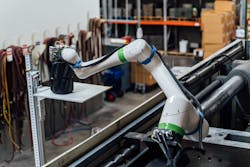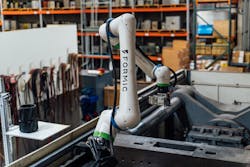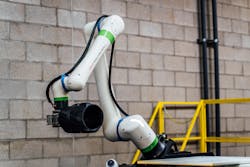An Injection Molder Embraces Emergent Technology with Robotics as a Service
Founded in 2001, family-owned, Phoenix-based ICON Injection Molding caters to a range of industries, making parts for laboratory use, security devices, pool equipment and more. “With a dedication to ‘Excellence from Art to Part,’ we have grown organically to become a go-to provider of custom plastic injection molding,” says Nicole Kleitsch-Killam, chief administrative officer at ICON. “It also means that if a customer wants to order only 1,000 parts this month and 100,000 next month, we have to be able to react.”
The impetus for ICON to explore automation arose when the company was faced with a specific project that required operators to repeatedly retrieve 300°F hot plastic parts and place them in a cooling bath. According to Kleitsch-Killam, the project required that operators stand on their feet for the entire workday to complete the task. “This repetitive manual process led to concerns about both worker safety and operational inefficiencies,” she says.
“While our operators faced persistent minor injuries such as burns, as well as a high risk of more serious injuries, our overnight and weekend shifts were marred by inconsistent staffing levels that led to disruptions.” She says as they grappled with the resulting high worker turnover, inconsistent output, longer lead times and higher prices for end customers, “We knew automation was the answer to both challenges.”
READ MORE: Pittsburgh Welcomes Robotics Factory to Foster Innovation and Growth
Understanding a Robotics-as-a-Service Solution
Kleitsch-Killam says ICON initially reached out to a familiar conventional vendor, but the capital expenditure (CapEx) was too high and only covered the robotic unit—not any of the essential auxiliary equipment.
“Automation seemed out of reach, financially, until our CEO asked Jeff Galindo, our executive operations specialist, to find a solution,” she explained. “An industry friend introduced him to Formic, and he was blown away. With no upfront CapEx and a low $10/hour rate, Formic’s ‘Robotics-as-a-Service’ model just seemed too good to be true. We were even more impressed to learn that Formic would manage the maintenance, upkeep and programming of the system.”
Under Formic’s pay-for-productivity RaaS model, ICON pays for the operation of the robots when they are actively deployed. This hourly payment structure avoids a large CapEx spend and still reaps automation benefits.
Misa Ilkhechi, co-founder and vice president of product and partnerships at Formic, says, “Formic owns, programs, installs and maintains robotic systems from vendors like FANUC, Universal Robots and Yaskawa Motoman at its own cost, assuming the financial risk for customers…Put simply, if any of our systems don’t work or fail to hit the agreed-upon productivity metrics, we don’t get paid, so we’re literally invested in keeping them running well.”
As Formic grows, it is creating a library of automation solutions that can do everyday tasks, Ilkhechi explains, “so that even as we customize solutions, we don’t have to continuously reinvent the wheel.” At the same time, Formic is creating a platform where the company purchases hardware in bulk, which solves supply chain issues and reduces the cost and access to hardware for its customers and for other sub-component and system integrators that sit between Formic and the hardware, he says. “As Formic builds its knowledge and hardware base, it will be able to lower subscription costs and continue to democratize automation for U.S. manufacturers.”
READ MORE: Automate 2023: A Robotics & Automation Event Organized Around Market Trends
RaaS is Adaptable as Needs Evolve
ICON and Formic collaborated to design and deploy a custom automated solution. Taking a technology-agnostic approach, Formic sourced hardware and software components from a range of suppliers, taking performance and suitability for ICON’s needs into consideration. The RaaS offering also adapts as needs evolve.
With a command center for remote login, Formic monitors its systems 24/7 to moderate temperatures, look for anomalies and find opportunities to improve usage and performance, according to Ilkhechi. “In addition, when a customer’s needs change, we can reprogram systems to accommodate new projects. And for customers with Formic Flex, we can even swap out their entire system—all at no cost to them,” he notes.
Kleitsch-Killam adds, “We can also monitor our system via a handy app, but Formic is committed to identifying and fixing problems before they even arise.”
She says the onsite staff training was an informative six-hour-long, hands-on course. “The cell includes a customized robotic machine operator (a 6-axis articulated FANUC robot arm), which was installed on our largest injection molding press, a 720-ton Nissei FV9100 that is over 20 years old,” she says. “It also includes a vertical conveyor that fully automates the process of loading, unloading and lowering the finished parts into the cooling bath for the final annealing process. This project consists of eight different parts, and programs for each size are set by Formic and maintained with software from Rockwell Automation.”
Increased Performance, Future Growth Opportunities
Since implementing RaaS, ICON has experienced significant improvements across various performance indicators, including a 20% increase in production, a 40% reduction in operational expenses and a 30% improvement in cycle-time efficiency, according to Kleitsch-Killam.
The workplace is not only safer, but employee satisfaction is up and there is a reduction in employee turnover. Kleitsch-Killam says ICON’s corporate management team tries to frame the use of automation as a “productivity enhancer” rather than a “person replacer,” but there was initial skepticism from some of their long-time employees. “Once they saw that nobody was getting laid off to ‘make room’ for this automation, however, they recognized how much easier and safer it made their job. Those working on the less-staffed overnight and weekend shifts, in particular, now see much more opportunity to take on skilled roles within the company than before.
“This collaboration with Formic has been a case study of sorts for us, reflecting the potential of RaaS and its impact on ICON's future,” she continues. “Right now, we’re focused on expansion to a new building on our premises, which ultimately means we’ve got room to amplify the role of robotics in what we do…We look forward to collaborating with Formic to determine what project or task to automate next.”
About the Author
Sharon Spielman
Technical Editor, Machine Design
As Machine Design’s technical editor, Sharon Spielman produces content for the brand’s focus audience—design and multidisciplinary engineers. Her beat includes 3D printing/CAD; mechanical and motion systems, with an emphasis on pneumatics and linear motion; automation; robotics; and CNC machining.
Spielman has more than three decades of experience as a writer and editor for a range of B2B brands, including those that cover machine design; electrical design and manufacturing; interconnection technology; food and beverage manufacturing; process heating and cooling; finishing; and package converting.
Email: [email protected]
LinkedIn: @sharonspielman
Facebook: Machine Design
YouTube: @MachineDesign-EBM





